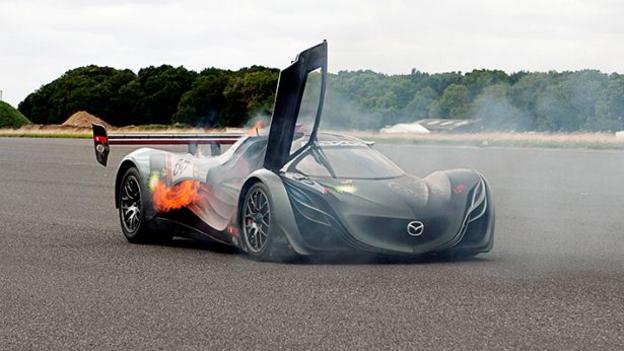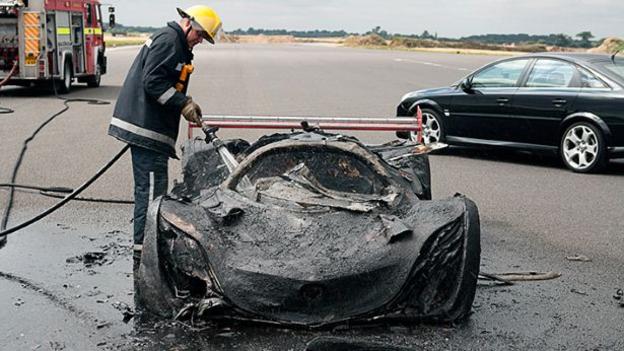Sunday, March 15, 2015
On August 19, 2008 the Mazda Furai died going around the runway at Top Gear. It was one of the last runs and Lee is trying to capture a small cone of blue flame coming out of the exhaust pipe, when suddenly the Furai starts making odd noises and then catches fire with the driver still inside. The fire department was not able to get there fast enough but the driver had escaped fast enough.



In 2007, Mazda design team set out to work on a series of concept vehicles that were meant to illustrate Mazda's corporate philosophy. One aspect of this project was the idea of "bringing to life" one of these concept cars to show the world that great designs could be brought forward from paper, to concept, to completion. During the development of the Furai concept race vehicle, Mazda approached Racing Beat with the request to build a ethanol-powered 3-rotor peripheral port intake engine for use in the vehicle. In mid-2007, this engine was assembled, tested, and installed into the Furai vehicle by Racing Beat. Jim Mederer, Racing Beat's cofounder and chief engineer, oversaw this engine project from inception to completion. Jim's signature touch was the design and hand-fabrication of the rotary-shaped muffler canister that was included on the Furai concept vehicle.http://www.racingbeat.com/mazda/performance/projects/mazda-furai.html
It is the 5th design in the "Nagare" design concept series, and the word Furai, means "the sound of the wind". It was manufactured based on the Courage C65 chassis used by Mazda in the ALMS P2 racing class, and was mounted with a 3 rotor R20B rotary engine producing 444 BHP. As an environmentally friendly super performance machine, it is fuelled by BP's ethanol fuel, E100. The use of the 100% ethanol fuel in the rotary engine opens new doors for the possibilities of rotary engines in the future.
But aside from the Environmental performance and specs, the true attraction of the Furai is in its design. From the concept of 'a racing car cutting through wind', its form utilises sharp lines flowing into soft curves, whilst executing effective aerodynamics. It has a distinctly Japanese flavour about it, and the delicate perfection of the design was highly praised by many, generating a large number of fans. The motifs from the front mask, utilising flowing multilayered fins, lives on in the new Axela (Mazda 3) announced in 2009.
The Furai also performed test drives on the Laguna Seca, and drove publicly at the Goodwood Festival of Speed, entertaining visitors with its unique form and resonating rotary sound.
Mazda holds the record for winning the Le Mans with a rotary engine race car. The Furai is a car that brings to life a dream and possibility, that the rotary engine may once again return to the Le Mans in the future.http://gran-turismo.wikia.com/wiki/Mazda_Furai_Concept_'08
Over a period of three years between 2005 and 2008, Mazda produced some stunning design concepts showcasing its ‘Nagare' design language. And although Mazda subsequently evolved Nagare into the ‘Kodo' theme in 2011 with the Shinari concept (translated into road-going metal like the CX-5 and Mazda6) the Nagare dynasty remains a glimpse into a world where Mazda designers were set free to push boundaries. There were no limits or restrictions. The Furai? Basically the poster boy of Nagare, the last and most eye-popping vehicle to be born of that philosophy. Created as a concept to show how a racecar for the road might look, it was the brainchild of a design department deeply proud of its motorsport heritage, the most extreme concept of its generation. It won global acclaim, but was more than that: the Furai was possibly the defining concept car of its era. Which makes what happens next all the more tragic.http://www.topgear.com/uk/photos/mazda-furai-concept-fire-2013-11-29

Subscribe to:
Posts (Atom)
